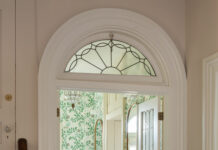Shocking.
There’s no other word to describe the wind that came up from my basement, blew through my dining room and ruffled my pant legs as I stood near the front door with home energy auditor David Brosch.
Then again, expensive might be apt. Or wasteful.
Brosch recently started his own home energy audit business, Green Home/Blue Sky, after roughly 10 years of working through Baltimore City’s Weatherization Assistance Program to increase the energy efficiency of homes owned by low-income families. I’d paid him $300 to come to my Charles Village rowhouse to answer every homeowner’s most pressing seasonal question: How can I get the warmest house for my dollar?
Brosch began by interviewing me about my energy usage, scanning my utility bills and making some general energy-smart suggestions. But the audit really took off once he assembled a contraption called a blower door— essentially a high-powered fan outfitted with a pressure gauge and a nylon apron that created an airtight seal across my front door. Once Brosch flipped the switch, the blower door began exerting such a strong force that it not only sucked up the air inside the house, but it also pulled in air from outside through the only openings available, given that my doors and windows were closed: leaks.
Bit by bit, Brosch cranked the blower door to the highest speed, but he wasn’t able to raise the pressure in my house to the recommended threshold. That meant he had to do some extra calculations to compute my home’s air infiltration rate— 7,240 cubic feet per minute. It also meant, as he said, that I was harboring “some major air leaks, to put it mildly.”
With the blower door still running, we commenced a room-to-room search for leaks, which are best detected by a simple method: putting your hand along a wall or window opening and feeling for blowing air. “The blower door really makes it possible to feel the leaks because it exaggerates them,” said Brosch. “Before people used it, they were guessing. It also helps you prioritize the big leaks and move on.” Speaking of big leaks, Brosch crouched in front of the fireplace in the dining room and reached his hand up into the chimney. “There is a huge leak here,” he said. “You’ve got heat loss 24 hours a day.”
Sticking my hand up the chimney felt like sticking my hand out an open window— which, we discovered, was more or less what it was. When Brosch shined his flashlight up, we saw that some previous owner had attempted to seal off the flue, but hadn’t quite completed the job. “Since you don’t use the fireplace, you could get a piece of insulation, put it in a trash bag, and stuff it up there, making sure it conforms to the space,” Brosch told me.
“Will do,” I said, happy at discovering both a leak and a quick, easy— and cheap— solution to plugging it.
In my first-floor bathroom, Brosch pointed out a gap in the plaster ceiling where the radiator pipes go through. I stood on the toilet, stretched my hand up and sure enough: a breeze. This wasn’t as bad as the fireplace— more of a zephyr than anything— but still Brosch recommended caulking. “Every little bit helps,” he said.
Every little bit does help, but by this point, I was antsy to hunt for big game. Judging from the wind coming up from the basement, I was sure we’d uncover a Grand Canyon-size hole that somehow I’d overlooked during five years of living in my house.
Alas, the first few discoveries in the basement were minor. The basement back door doesn’t seal well and needs weather stripping. The rim/band joists where the floorboards above meet the basement walls need to be sealed with foam to prevent cold air from traveling all the way from the basement to the attic. A loose windowpane near the furnace needs to be reglazed.
Then Brosch opened the door that leads to the portion of the basement under my front porch, took a few steps toward the corner and put out his hand. Big game! “We’ve got a little hurricane right here,” he said, and when he shined his flashlight back into the corner, I saw cobwebs dancing. “This is a 6-by-6-inch hole and it’s open to the outside, to the porch. You can heat the house all you want, but the cold air will always come in here. Getting this blocked— you could use insulated board and foam— would make a huge difference. If I did one thing, I’d do this.”
I’d always known the room under the porch was cold, but I’d never stopped to think it was due to an air leak— or that sealing the leak would not only make that room warmer, but also my whole house. Which is to say that until I made Brosch’s acquaintance, I didn’t understand the importance of resisting the “stack effect” by reducing the amount of cold air that gets sucked into the basement and pulled up through the rest of the house. In fact, I’d never paid that much attention to my basement at all, even though Brosch says basements and attics are where the action is when it comes to energy efficiency. “People always think their windows need to be replaced in order to significantly increase their home’s efficiency,” said Brosch. “Most of the time if you caulk and foam leaks at the top and bottom, you’ll get a bigger gain for less than the cost of a window.”
I got off lightly with my windows— he recommended filling cracks with a clear caulk and fixing a window that doesn’t seal completely— but the same wasn’t true in my attic, which I’m ashamed to say I had never explored before Brosch’s visit. Brosch discovered that my insulation consisted of a couple of inches of rock wool probably original to the home— i.e. 100 years old— and only insulating at R-6 (R-1 is the insulation offered by the ceiling itself). Brosch recommended I have cellulose insulation blown in to R-30 (required by today’s building standards). Whereas sealing leaks would block cold air from coming into the basement (convection), insulation would keep heat from being lost through the ceiling (conduction)— and the two actions together, Brosch said, would provide a noticeable improvement in energy efficiency.
Tucker Smith at Northeast Energy Services studied Brosch’s report then gave me an estimate for the leak-sealing and insulating. It wasn’t cheap, but I decided it was worth it— both for my increased comfort and in reduced costs to both myself and Mother Nature.
On a recent Saturday, after Smith’s crew had finished sealing the leaks— and I’d stuffed a bag of insulation, in addition to a few old shirts for good measure, into my fireplace— he set up the blower door, flipped the switch and reported that he could now raise the pressure in my house to the recommended threshold. That was good news. Even better was the reading on the gauge on the blower door: the sealing had cut my home’s air infiltration rate to 5,500 cubic feet per minute, a reduction of 24 percent. That meant less cold air was now sneaking in uninvited.
Even without the gauge, I could tell the difference. The wind from the basement had calmed to a balmy island breeze.
resources
David Brosch, Green Home/Blue Sky Holistic House
Audit, 301-779-3168
Tucker Smith, Northeast Energy Services, 410-876-9122
Terralogos Green Home Services also offers home energy audits. 443-451-7130, http://www.terralogos.com




